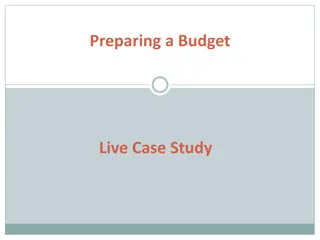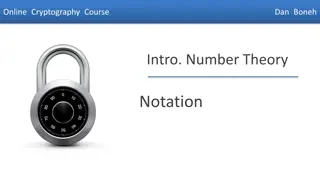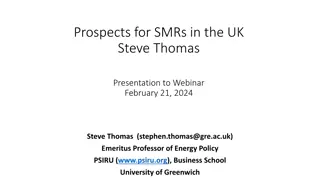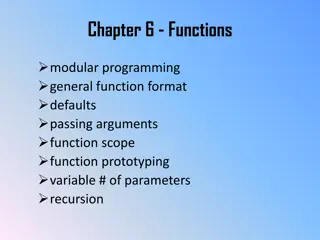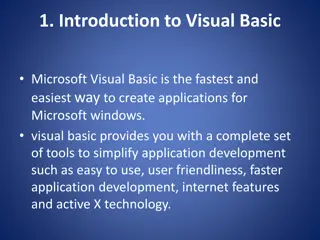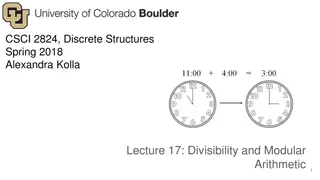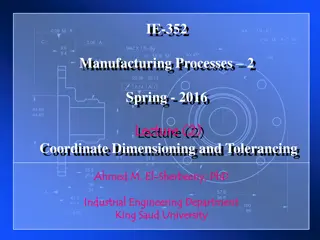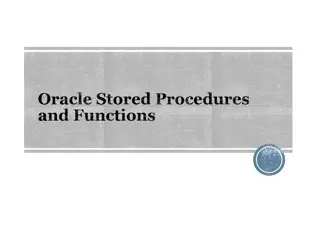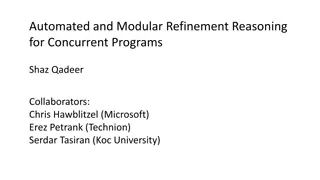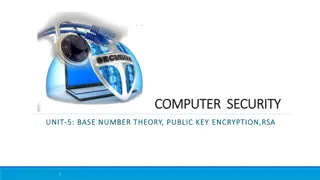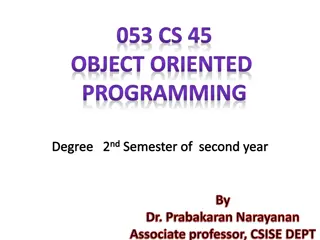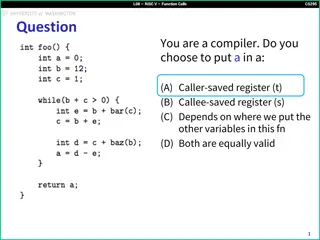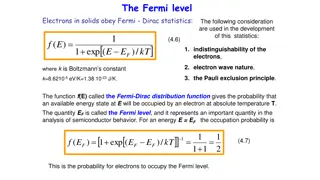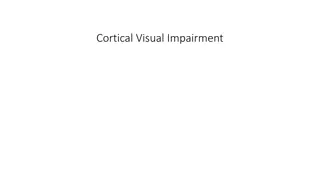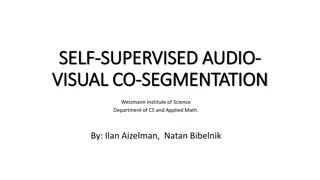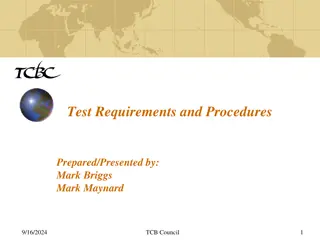Understanding Function Procedures and Modular Design in Visual Basic
Learn about function procedures, modular design, and user-defined functions in Visual Basic programming with examples of built-in functions and procedures. Explore the concept of breaking down problems into smaller pieces for efficient programming.
Download Presentation

Please find below an Image/Link to download the presentation.
The content on the website is provided AS IS for your information and personal use only. It may not be sold, licensed, or shared on other websites without obtaining consent from the author. Download presentation by click this link. If you encounter any issues during the download, it is possible that the publisher has removed the file from their server.
E N D
Presentation Transcript
1 Edited By Maysoon Al-Duwais
General Procedures Function Procedure Sub Procedures, Part I Sub Procedures, Part II Modular Design 2 Edited By Maysoon Al-Duwais
Devices for Modularity Visual Basic has two ways for breaking problems into smaller pieces: Function procedures Sub procedures 3 Edited By Maysoon Al-Duwais
Function Procedures User-Defined Functions Having One Parameter User-Defined Functions Having Several Parameters User-Defined Functions Having No Parameters User-Defined Boolean-Valued Functions 4 Edited By Maysoon Al-Duwais
Some Built-In Functions Function: Int Example: Int(2.6) is 2 Input: number Output: number Function: Math.Round Example: Math.Round(1.23, 1) is 1.2 Input: number, number Output: number 5 Edited By Maysoon Al-Duwais
Some Built-In Functions (continued) Function: FormatPercent Example: FormatPercent(0.12, 2) is 12.00% Input: number, number Output: string Function: FormatNumber Example: FormatNumber(12.62, 1) is 12.6 Input: number, number Output: string 6 Edited By Maysoon Al-Duwais
Function Procedures Function procedures (aka user-defined functions) always return one value Syntax: Function FunctionName(ByVal var1 As Type1, ByVal var2 As Type2, ...) As ReturnDataType statement(s) Return expression End Function 7 Edited By Maysoon Al-Duwais
Example With One Parameter Function FtoC(ByVal t As Double) As Double 'Convert Fahrenheit temp to Celsius Return (5 / 9) * (t - 32) End Function 8 Edited By Maysoon Al-Duwais
Header of the FtoC Function Procedure 9 Edited By Maysoon Al-Duwais
Example 1: Form txtTempF txtTempC 10 Edited By Maysoon Al-Duwais
Example 1: Code Using Function Private Sub Convert(...) Handles btnCnvrt.Click Dim fTemp, cTemp As Double fTemp = txtTempF.Text cTemp = FtoC(fTemp) txtTempC.Text = cTemp End Sub Function FtoC(ByVal t As Double) As Double Return (5 / 9) * (t - 32) End Function 11 Edited By Maysoon Al-Duwais
Example 1: Code Without Using Function Private Sub btnConvert_Click(...) _Handles btnConvert.Click Dim fTemp, cTemp As Double fTemp = txtTempF.Text cTemp = (5 / 9) * (fTemp - 32) txtTempC.Text = cTemp End Sub Edited By Maysoon Al-Duwais 12
Example 1: Output 13 Edited By Maysoon Al-Duwais
User-Defined Function Having Several Parameters Function Pay(ByVal wage As Double, ByVal hrs As Double) As Double Dim amt As Double Total amount of salary per hour Select Case hrs Case Is <= 40 amt = wage * hrs Case Is > 40 the wage (salary/hour) increases 50% per every extra hour (extra hours >40) amt = wage * 40 +(0.5 * wage * (hrs 40)) End Select Return amt End Function 14 Edited By Maysoon Al-Duwais
Example 3: Form txtWage txtHours txtEarnings 15 Edited By Maysoon Al-Duwais
Example 3: Partial Code Private Sub btnCalculate_Click(...) _ Handles btnCalculate.Click Dim hourlyWage, hoursWorkded As Double hourlyWage = txtWage.Text hoursWorked = txtHours.Text txtEarnings.Text = FormatCurrency(Pay(hourlyWage, hoursWorked)) End Sub Function call 16 Edited By Maysoon Al-Duwais
Example 3: Output 17 Edited By Maysoon Al-Duwais
User-Defined Function Having No Parameters Function CostOfItem() As Double Dim price As Double = CDbl(txtPrice.Text) Dim quantity As Integer = CDbl(txtQuantity.Text) Dim cost = price * quantity Return cost End Function 18 Edited By Maysoon Al-Duwais
User-Defined Function Having Several Parameters Function Pay(ByVal wage As Double, ByVal hrs As Double) As Double Dim amt As Double Total amount of salary Select Case hrs Case Is <= 40 amt = wage * hrs Case Is > 40 the wage (salary/hour) increases 50% per every extra hour (extra hours >40) amt = wage * 40 +(0.5 * wage * (hrs 40)) End Select Return amt End Function 19 Edited By Maysoon Al-Duwais
Example 3: Form txtWage txtHours txtEarnings 20 Edited By Maysoon Al-Duwais
Example 3: Partial Code Private Sub btnCalculate_Click(...) _ Handles btnCalculate.Click Dim hourlyWage, hoursWorkded As Double hourlyWage = txtWage.Text hoursWorked = txtHours.Text txtEarnings.Text = Pay(hourlyWage, hoursWorked) End Sub Function call 21 Edited By Maysoon Al-Duwais
Example 3: Output 22 Edited By Maysoon Al-Duwais
User-Defined Function Having No Parameters Function CostOfItem() As Double Dim price As Double = CDbl(txtPrice.Text) Dim quantity As Integer = CDbl(txtQuantity.Text) Dim cost = price * quantity Return cost End Function 23 Edited By Maysoon Al-Duwais
User-Defined Boolean-Valued Function Function IsVowelWord(ByVal word As String) As Boolean If word.IndexOf("A") = -1 Then Return False End If . . If word.IndexOf("U") = -1 Then Return False End If Return True End Function 24 Edited By Maysoon Al-Duwais
Sub Procedures, Part I Defining and Calling Sub Procedures Variables and Expressions as Arguments Sub Procedures Calling Other Sub Procedures 25 Edited By Maysoon Al-Duwais
General Form of Sub Procedure 26 Edited By Maysoon Al-Duwais
Calling a Sub Procedure The statement that invokes /calls a Sub procedure is referred to as a calling statement. A calling statement looks like this: ProcedureName(arg1, arg2,..., argN) 27 Edited By Maysoon Al-Duwais
Naming Sub Procedures The rules for naming Sub procedures are the same as the rules for naming variables. 28 Edited By Maysoon Al-Duwais
Passing Values DisplaySum( 2, 3 ) Sub DisplaySum(ByVal num1 As Double, ByVal num2 _ As Double) Dim z As Double z = num1 + num2 lstOutput.Items.Add("The sum of " & num1 & " and " & num2 & " is " & z & ".") End Sub In the Sub procedure, 2 will be stored in num1 and 3 will be stored in num2 29 Edited By Maysoon Al-Duwais
Arguments and Parameters Sum(2, 3) arguments parameters Sub DisplaySum(ByVal num1 As Double, ByVal num2 _ As Double) displayed automatically 30 Edited By Maysoon Al-Duwais
Several Calling Statements DisplaySum(2, 3) DisplaySum(4, 6) DisplaySum(7, 8) Output: The sum of 2 and 3 is 5. The sum of 4 and 6 is 10 The sum of 7 and 8 is 15. 31 Edited By Maysoon Al-Duwais
Passing Strings and Numbers Demo("CA", 38) Sub Demo(ByVal state As String, ByVal pop _ As Double) lstOutput.Items.Add = state & " has population " & pop & " million." End Sub Note: The statement Demo(38, "CA") would not be valid. The types of the arguments must be in the same order as the types of the parameters. 32 Edited By Maysoon Al-Duwais
Variables and Expressions as Arguments Dim s As String = "CA" Dim p As Double = 19 Demo(s, 2 * p) Sub Demo(ByVal state As String, ByVal pop _ As Double) lstOutput.Items.Add = state & " has population " & pop & " million." End Sub Note: The argument names need not match the parameter names. For instance, s versus state. 33 Edited By Maysoon Al-Duwais
Sub Procedure Having No Parameters Sub DescribeTask() lstBox.Items.Clear() lstBox.Items.Add("This program displays") lstBox.Items.Add("the name and population") lstBox.Items.Add("of a state.") End Sub 34 Edited By Maysoon Al-Duwais
Sub Procedure Calling Another Sub Procedure Private Sub btnDisplay_Click(...) Handles _ btnDisplay.Click Demo("CA", 37) End Sub Sub Demo(ByVal state As String, ByVal pop _ As Double) DescribeTask() lstOutput.Items.Add("") lstOutput.Items.Add = state & " has population " & pop & " million." End Sub 35 Edited By Maysoon Al-Duwais
Output This program displays the name and population of a state. CA has population 37 million. 36 Edited By Maysoon Al-Duwais
Sub Procedures, Part II Passing by Value Passing by Reference Sub Procedures that Return a Single Value Lifetime and Scope of Variables and Constants Debugging 37 Edited By Maysoon Al-Duwais
ByVal and ByRef Parameters in Sub procedure headers are proceeded by ByVal or ByRef ByVal stands for By Value ByRef stands for By Reference 38 Edited By Maysoon Al-Duwais
Passing by Value When a variable argument is passed to a ByVal parameter, just thevalueof theargument is passed. After the Sub procedure ends, the variable has its original value. 39 Edited By Maysoon Al-Duwais
Example Public Sub btnOne_Click (...) Handles _btnOne.Click Dim n As Double = 4 Triple(n) txtBox1.Text = n = & n End Sub Argument different name (num) name than (n) is parameter Sub Triple(ByVal num As Double) num = 3 * num txtBox2.Text = num = & num End Sub Memory (RAM): 12 4 n Output: num num = 12 n = 4 40 Edited By Maysoon Al-Duwais
Same Example: n num Public Sub btnOne_Click (...) Handles _btnOne.Click Dim num As Double = 4 Triple(num) txtBox1.Text = 2. num = & num End Sub Argument name (num) is same as the parameter name (num) Sub Triple(ByVal num As Double) num = 3 * num txtBox2.Text = 1. num = & num End Sub Memory (RAM): 12 4 Output: num num 1. num = 12 2. num = 4 41 Edited By Maysoon Al-Duwais
Passing by Reference When a variable argument is passed to a ByRef parameter, the parameter is given the same memory locationas theargument. After the Sub procedure terminates, the variable has thevalueof the parameter. 42 Edited By Maysoon Al-Duwais
Example Public Sub btnOne_Click (...) Handles _ btnOne.Click Dim num As Double = 4 Triple(num) txtBox2.Text = 2. num = & num End Sub Argument name (num) is the same as parameter (num) name Sub Triple(ByRef num As Double) num = 3 * num txtBox1.Text = 1. num = & num End Sub Memory (RAM): Output: 4 12 X 1. num = 12 num 2. num = 12 43 Edited By Maysoon Al-Duwais
Example: num n Private Sub btnOne_Click(...) Handles _btnOne_Click Dim n As Double = 4 Triple(n) txtBox1.Text = n = & num End Sub Argument different name (num) name than (n) is parameter Sub Triple(ByRef num As Double) num = 3 * num txtBox1.Text = num = & num End Sub Memory (RAM): Output: 4 12 X num n num = 12 n = 12 44 Edited By Maysoon Al-Duwais
Most Common Use of ByRef: Get Input (Read Input) Sub InputData(ByRef wage As Double, ByRef hrs As Double) wage = CDbl(txtWage.Text) hrs = CDbl(txtHours.Text) End Sub 45 Edited By Maysoon Al-Duwais
Lifetime and Scope of a Variable Lifetime: Period during which it remains in memory. Scope: In Sub procedures, defined same as in event procedures. Suppose a variable is declared in procedure A that calls procedure B. While procedure B executes, the variable is alive, but out of scope. 46 Edited By Maysoon Al-Duwais
Functions vs. Sub procedures Both can perform similar tasks Both can call other procedures Use a function when you want to return one and only one value 47 Edited By Maysoon Al-Duwais




